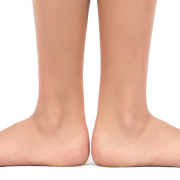Flat feet and Scoliosis
Scoliosis is a complex structural deformity of the dorsal spine in all three planes of space. Frontally, scoliosis is identified as a lateral bending of the spine, from the side (sagittal view) as an alteration of the spine’s physiological kyphosis and lordosis (i.e. natural curves, which can appear reversed), and axially as a rotation of the spine.
A flat foot, on the other hand, is a dysmorphism where the anatomy of the foot is altered: the plantar arch is less prominent than it should be, and increases the weight-bearing surface of the foot.
In babies and toddlers, flat feet are physiological (perfectly normal), being observed in nearly all children aged from 0 to 2 years (97%), before becoming progressively less frequent as they grow. Around 50% of children still have flat feet at three years of age and 25% at six years, whereas by the age of 10, very few children still have it.
Basically, it takes some time to form the plantar arch and the heel to begin to turn outwards rather than inwards. If flat feet persist in adolescence, it is a good idea to consult a specialist in disorders of the foot.
There are two “alarm signals” that should be brought to the attention of the family doctor, namely, if the youngster has difficulty walking, or if you notice that the plantar arch is not evident when he/she rises on tiptoes. In the literature, it is agreed that walking barefoot (particularly on an uneven surface like ground, grass or sand) stimulates the formation of the plantar arch, by training the different muscle groups involved.
To date, there are no articles in the literature that actually link the problem of flat feet to the development of scoliosis: some articles just point out that flat feet and scoliosis are problems that can coexist in growing subjects; that said, the majority of the few articles that do mention both conditions refer to subjects with neurological disorders.
Therefore, although a spine specialist may as well ask a patient to stand on a podoscope (in order to carefully assess the pressure areas under the feet), beware of thinking that flat feet can affect the spine or cause it to deviate.

